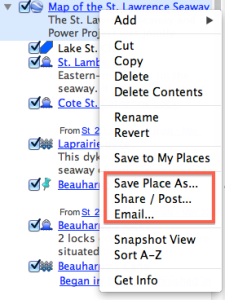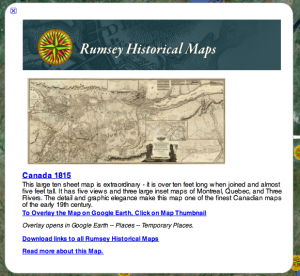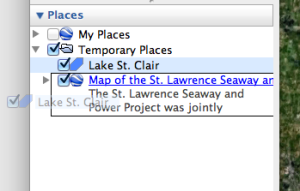Google Earth
Google Earth works in much the same way as Google Maps Engine Lite, but has additional features. For example, it provides 3-D maps and access to data from numerous third party sources, including collections of historical maps. Google Maps doesn’t require you to install software and your maps are saved in the cloud. Google Earth requires software installation and is not cloud-based, though maps you create can be exported.
- Install Google Earth: http://www.google.com/earth/index.html
- Open the program and familiarize yourself with the digital globe. Use the menu to add and remove layers of information. This is very similar to how more advanced GIS programs work. You can add and remove different kinds of geographical information including Political Boundaries (polygons), Roads (lines), and Places (points). See the red arrows in the following image for the location of these layers.
- Note that under the “Layer” heading on the lower left side of the window margin, Google provides a number of ready-to-go layers that can be turned on by selecting the corresponding checkbox.
- Google Earth also contains some scanned historical maps and aerial photographs (in GIS these types of maps, which are made up of pixels, are known as raster data). Under Gallery you can find and click Rumsey Historical Maps. This will add icons all over the globe (with a concentration in the United States) of scanned maps that have been georeferenced (stretched and pinned to match a location) onto the digital globe. This previews a key methodology in historical GIS. (You can also find historical map layers and other HGIS layers in the Earth Gallery). Take some time to explore a number of historical maps. See if there are any maps included in the Rumsey Collection that might be useful for your research . (You can find many more digitized, but not georeferenced maps at www.davidrumsey.com.)
- You might need to zoom in to see all of the Map icons. Can you find the World Globe from 1812?

- Once you click on an icon an information panel pops up. Click on the map thumbnail to see the map tacked onto the digital globe. We will learn to properly georeference maps in a separate lesson lesson 4.
KML: Keyhole Markup Language files
- Google developed a file format to save and share map data: KML. This stands for Keyhole Markup Language, and it is a highly portable type of file (i.e. a KML can be used with different types of GIS software) that can store many different types of GIS data, including vector data.
- Maps and images you create in Google Maps and Google Earth can be saved as KML files This means you can save work done in Google Maps or Google Earth. With KML files you can transfer data between these two platforms and bring your map data into Quantum GIS or ArcGIS.
- For example, you can import the data you created in Google Maps Engine Lite. If you created a map in the exercise above, it can be found by clicking “Open Map” on the Maps Engine Lite home page. Click on the folder icon on the left hand side of the legend beneath the map title and click “export to KML”. (You can also download and explore Dan Macfarlane’s Seaway map for this part of the exercise).
Bringing your KML file into Google Earth
- Download the KML file from Google Maps Engine Lite (as described above).
- Double click on the KML file in your Download folder.
- Find the data in the Temporary Folder in Google Earth.
- You can now explore these map features in 3D, or you can add new lines, points and polygons using the various icons along the top left of your Google Earth window (see image below). This works in essentially the same way as it did for Google Maps, although there is more functionality and options. In Dan’s Seaway map, the old canals and current Seaway route were traced in different line colours and widths using the line feature (this was made possible by overlaying historical maps, which is described below), while various features were marked off with appropriate Placemarks. For those so inclined, there is also the option of recording a tour that could be useful for presentations or teaching purposes (when the “record a tour” icon is selected, recording options will show up on the bottom left of the window).
- Try adding a new feature to Dan’s Seaway data. We’ve created a polygon (in GIS terminology a polygon is a closed shape of any type – a circle, hexagon, and square are all examples) of Lake St. Clair in the next image. Find Lake St. Clair (east of Detroit) and try adding a polygon.

- Label the new feature Lake St. Clair. You can then drag the new feature onto Dan’s Seaway data and add it to the collection. You can then save this expanded version of the Seaway map as a KML to share via email, upload into Google Maps, or to export this data into QGIS. Find the save option by right-clicking on the Seaway collection and choose Save Place As or Email.


Adding Scanned Historical Maps
Within Google Earth, you can upload a digital copy of a historical map. This could be a map that has been scanned, or an image obtained that is already in a digital format (for tips on finding historical maps online see: http://niche-canada.org/node/10239). The main purpose for uploading a digital map, from a historical perspective, is to place it over top of a Google Earth image in the browser. This is known as an overlay. Performing an overlay allows for useful comparisons of change over time.
- Start by identifying the images you want to use: the image within Google Earth, and the map you want to overlay with. For the map you want to overlay, the file can be in JPEG or TIFF format, but not PDF.
- Within Google Earth, identify the area of the map you want to overlay. Note that you can go back in time (i.e. look at older satellite photos) by clicking on the “Show historical imagery” icon on the top toolbar. and then adjusting the time-scale slider that will appear.

- Once you have identified the images you plan to use, click on the “Add Image Overlay” icon on the top toolbar.
- A new window will appear. Begin by giving it a different title if you wish (the default is “Untitled Image Overlay”).
- To the right of the Link field, click the Browse button to select from your files the map you wish to be the overlaying image.
- Move the New Image Overlay window out of the way (don’t close it or click “Cancel” or “OK”) so that you can see the Google Earth browser. The map you uploaded will now appear over top of the Google Earth satellite image in the Google Earth browser.
- There are fluorescent green markers in the middle and at the edges of the uploaded map. These can be used to stretch, shrink, and move the map so that it aligns properly with the satellite image. This is a simple form of georeferencing (see lesson 4). The image below shows the above steps using an old map of the town of Aultsville overlaid on top of Google satellite imagery from 2008 in which the remains of the town’s roads and building foundations in the St. Lawrence River are visible (Aultsville was one of the Lost Villages flooded out by the St. Lawrence Seaway and Power Project).

- Back in the New Image Overlay window, note that there are a range of options (Description, View, Altitude, Refresh, Location) that you can select. At this point, you likely don’t need to worry about these, although you may wish to add information under the Description tab.
- Once you are satisfied with your overlay, in the New Image Overlay window click on OK in the bottom right corner.
- You will want to save your work. Under File on your computer’s menu bar, you have two options. You can save a copy of the image (File -> Save -> Save Image…) you have created to your computer in jpg format, and you can also save the overlay within Google Earth so that it can be accessed in the future (File -> Save -> Save My Places). The latter is saved as a KML file.
- To share KML files simply locate the file you saved to your computer and upload it to your website, social media site, or send it as an email attachment.
You have learned how to use Google Maps and Earth. Make sure you save your work and post in your website!












